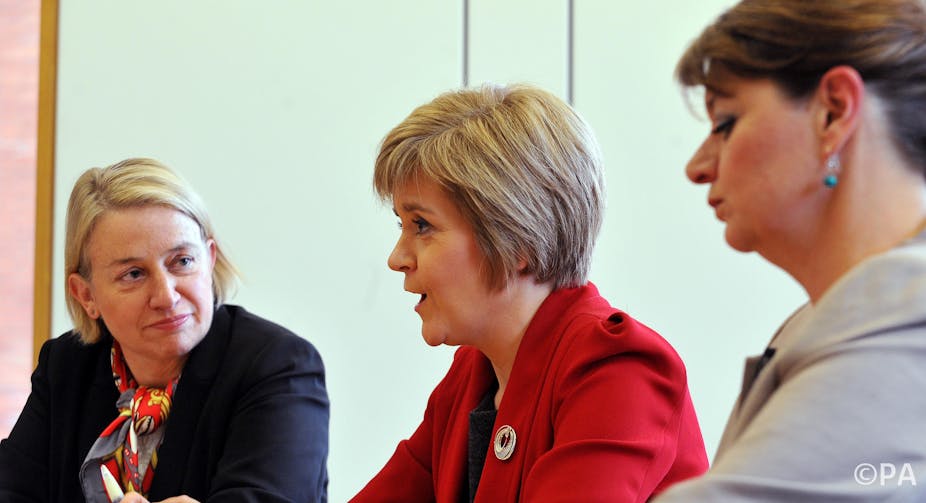Even the most ad hoc observer of British politics will surely know that the 2015 general election will revolve more than ever around the smaller political parties.
The combined result of the SNP, Plaid Cymru and the Green Party in the 2010 General Election was only 10 MPs and just 3% of the national vote. Just five years later, the Greens are polling at 7% and the SNP has been predicted to win a whopping 56 of the 59 seats up for grabs in Scotland. Green Party membership has quadrupled this year, from 13,000 to 55,000. The SNP has had similar good fortune, claiming to have 90,000 members at the end of last year.
Time to adjust
To many, the idea that any of these parties could be in government in just a couple of months’ time is highly implausible. Natalie Bennett’s car crash interview on LBC Radio certainly casts doubt on the capacity of their leaders to put forward a coherent and fully costed policy programme. Then there was the decision by former Plaid Cymru Dafydd Wigley to compare the Trident programme to Auschwitz – suggesting that his team are a long way from becoming media savvy.
And these stumbles aside, these parties don’t seem to be putting the big issues on top of their agendas. Despite the Green Party’s high profile at the moment, its Spring conference was awash with talk of nappy taxes and floating hospitals.
But it’s not a fantasy. In 2015, the smaller parties are more confident than ever before. There is a spring in their step and a sense of optimism in their discourse. All three have declared themselves ready and eager to debate with the bigger party leaders on national television. Nicola Sturgeon has even requested that her party join pre-election briefings with the civil service for the first time ever.
And crucially, they are already in talks about their plans to work together in the event of a minority Labour government.
The Green’s only sitting Caroline Lucas is talking of a “new grouping” and a “progressive alliance” in parliament.
Common Ground?
It might seem that there is no common ground between these three parties, aside from two of them being heavily focused on regional issues (only this weekend the SNP came out in support of Plaid’s call for government in Wales to receive the same funding settlement as Scotland).
But actually, there are some key messages that transcend any specific regional or environmental concerns. The most obvious of these is the anti-austerity rhetoric put forward by all three parties.
At Plaid’s Spring conference, Leanne Wood claimed a Plaid presence in government was the only alternative to “a blank cheque for further cuts” while Nicola Sturgeon has called for an end to the “cosy consensus” on austerity – something she has also described as the “depressive cuts agenda”. Sturgeon has even made increasing public spending a condition for any potential cooperation with Labour. Natalie Bennett concurred with this sentiment this weekend, calling for an end to the “failed austerity experiment”.

They are also united in their hatred of David Cameron’s Conservatives. The Greens have made it clear that they “would never, ever support a Conservative Government”. Hywel Williams, a Westminster MP for Plaid has said that “propping up a damaging Tory government will not be among Plaid Cymru’s commitments for the election”. The SNP have criticised Cameron’s arrogance in the TV debate debacle and censured Labour whenever one of their people hints at a Labour-Conservative coalition.
Even with some policy agreement, it would seem unlikely that so many parties could work together effectively but we must remember that while Labour and the Conservatives may baulk at the prospect of having to work with another party in Government, for small parties this is already business as usual. With only a handful of MPs in parliament, they have always had to work with others to get things done.
Caroline Lucas has spoken of working closely in the Commons with her SNP and Plaid colleagues. They also work together at the European level, where the MEPs from all three parties sit within the same parliamentary grouping – the Greens-European Free Alliance. They are starting to show good electoral tactics too, with Wigley asking Welsh voters living in England to vote for the Greens and suggesting that Green Party supporters in Wales reciprocate by voting for Plaid.
Bennett has said that this year will be the one in which her party takes its place at the forefront of UK politics. All three of these small parties will have a place in the forthcoming TV debates and will undoubtedly be hoping to pull off a performance worthy of Nick Clegg in 2010. This time though, instead of “I agree with Nick”, will we hear Ed Miliband agreeing with Leanne, Natalie or Nicola? Labour hasn’t completely ruled out this quadrumvirate.
And with Labour and the Conservatives neck and neck in the polls, one thing is certain; the morning of May 8 will bring a political landscape of the sort never seen before in British politics.

